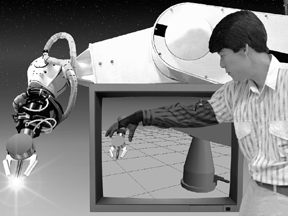In the year 2020 microscale robots with the ability to crawl, fly, and swim will work together to perform monitoring, surveillance, and intelligence operations. Larger robots will clean up radioactive spills, removing humans from hazardous situations. Still others will assemble weapons components that are now tediously built in clean rooms by people using microscopes and tweezers.

That’s the future of robotics as depicted in Robotics and Intelligent Machines in the US Department of Energy: A Critical Technology Roadmap, prepared by a collaborative team of DOE representatives and national laboratory scientists with input from additional DOE plants and sites.
"We looked ahead 20 years and identified roles robots can play in DOE’s multiple missions," says Pat Eicker, Director of Intelligent Systems and Robotics Center 9600. "If our plan is followed, we expect a robotics revolution by the year 2020."
Pat led a group of scientists from five national labs last year in developing a vision for the future and steps to get there. Three other groups, including representatives of DOE, various DOE sites, and federal agencies, were also involved in the project.
Sandians working with Pat on the roadmap included Al Jones (9672), Randy McKee (9672), Ray Harrigan (9623), Leslie Rettinger (9601), Bob Watson (9672), Kwan Kwok (9623), Marie Garcia (4311), Warren Klein (5100), and Olin Bray (4311).
The roadmap was a result of the request of the US Senate and House Task Forces on Manufacturing. They asked DOE, Department of Defense, the National Science Foundation, Commerce Department, and National Aeronautics and Space Administration (NASA) to "develop a common technological road map for advanced robotics and intelligent machines that identifies areas where fundamental research is most needed."
DOE Undersecretary Ernest Moniz, who championed the governmental use of the roadmapping concept in a previous position he held in the Office of Science and Technology Policy, appointed a roadmap development team. He sees the use of roadmaps as a way to identify, select, and develop objectives that will satisfy near- and long-term challenges posed by DOE’s missions.
The roadmap development group started meeting in March 1998. It had a first roadmap in July and a final one in November. The team presented it to Moniz and the DOE Research and Development Committee, which gave it a "ringing endorsement." Then, at Moniz’ direction, the team also prepared a detailed five-year program plan published last month.
"The five-year plan tells the various DOE program offices what will be accomplished in FY2001-2005 in a way that gives them confidence when making budget decisions," Pat says. "The 20-year plan is more visionary and looks at what types of technology are needed to make the vision happen."
The team is currently using the documents to line up the funding to make the robotic vision a reality. Some $80 million a year is needed for the robotics initiative to make the dream come true. That’s twice as much as the $40 million now being spent by DOE for robotics.
Development of the roadmap began with a discussion about needs of the nine DOE assistant secretaries, called Principal Secretarial Officers (PSOs). These fall into the areas of Defense Programs, Fissile Materials Disposition, Nuclear Energy Science and Technology, Nonproliferation and National Security, Environmental Management, Science, Environment Safety and Health, Energy Efficiency and Renewable Energy, and Fossil Energy. The PSOs’ needs can be succinctly summarized: lower costs, improve quality and productivity, and remove workers from hazards.
After hearing the needs, the roadmap development team identified areas and time frames in which advances in technology could play a role in meeting these goals. It then mapped out pathways, complete with timelines, to create the necessary technology. Pat says the fruits of their six-month labor on the project provide "a way to make our technological dreams a reality."
"We are on the threshold of a new era for robotics," he says. "Dramatic advances in other areas of science and technology are making possible a wide range of novel, sensor- and software-rich electromechanical devices with ever-increasing perception, reasoning, navigation, manipulation, and integration capabilities. This roadmap shows us the way to usher in that era taking advantage of the advances."
The roadmap is available on the External Web at http://sandia.gov/isrc, and the program plan is available from Pat.